Berg J.M., Tymoczko J.L., Stryer L. Biochemistry
Подождите немного. Документ загружается.


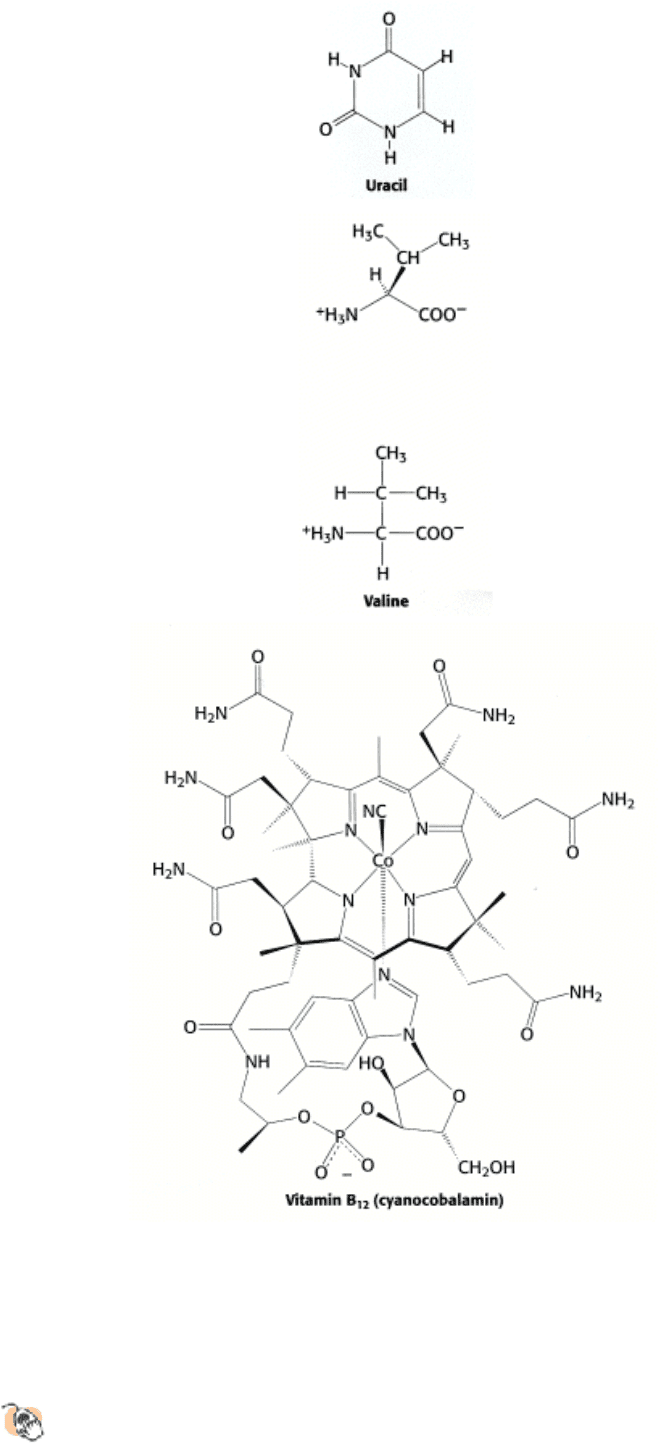
Answers to Problems
Need extra help? Purchase chapters of the Student Companion with complete
solutions online at www.whfreeman.com/biochem5.

Answers to Problems
Chapter 2
1.
The amino group comes from ammonia. All of the carbon atoms are derived from methane. The hydrogen atoms
bonded to the carbon atoms remain with the methane during bond formation or they may come from hydrogen gas.
The oxygen atoms of the carboxyl group are from water.
See question
2.
We start with 99 identical RNA molecules (which we will call L) that replicate in 15 minutes and 1 variant molecule
(which we will call S) that replicates in 5 minutes. After 15 minutes, we will have 2 × 99 = 198 molecules of L and
2
3
× 1 = 8 molecules of S since it replicates 3 times in 15 minutes. Thus, the population now contains 8/(8 + 198) =
3.9% S. After 10 generations, each molecule of L will have replicated 10 times while each molecule of S will have
replicated 30 times. The population will contain 1 × 2
30
/(1 × 2
30
+ 99 × 2
10
) = 99.991% S. After 25 generations, the
population will contain essentially all S and no L.
See question
3.
The mutation permits more efficient use of substrates and thus would be most beneficial when substrate is present in
low concentrations.
See question
4.
The formation of an ion gradient requires a reduction in entropy, which requires an input of free energy.
See question
5.
The decrease in free energy that results when the protons run down the ion gradient could be used to pump ions out
of the cell against a concentration gradient, an energy-requiring process.
See question
6.
Two protons per electron, or eight. The generation of four hydroxyl ions (OH
-
) is equivalent to the generation of four
protons (H
+
) on the other side of the membrane from which the reaction is taking place. The oxidation of water
produces four more protons.
See question
7.
Only the gene-control protein is necessary. The hydrophobic molecule can pass through the membrane on its own.
See question
8.
Approximately eight times.
See question

Answers to Problems
Chapter 3
1.
(a) Each strand is 35 kd and hence has about 318 residues (the mean residue mass is 110 daltons). Because the rise
per residue in an α helix is 1.5 Å, the length is 477 Å. More precisely, for an α-helical coiled coil the rise per residue
is 1.46 Å so that the length will be 464 Å.
(b) Eighteen residues in each strand (40 minus 4 divided by 2) are in a β-sheet conformation. Because the rise per
residue is 3.5 Å, the length is 63 Å.
See question
2.
The methyl group attached to the β-carbon atom of isoleucine sterically interferes with α-helix formation. In leucine,
this methyl group is attached to the γ-carbon atom, which is farther from the main chain and hence does not interfere.
See question
3.
The first mutation destroys activity because valine occupies more space than alanine does, and so the protein must
take a different shape, assuming that this residue lies in the closely packed interior. The second mutation restores
activity because of a compensatory reduction of volume; glycine is smaller than isoleucine.
See question
4.
The native conformation of insulin is not the thermodynamically most stable form since it contains two separate
chains linked by disulfide bonds. Insulin is formed from proinsulin, a single-chain precursor, that is cleaved to form
insulin with 33 residues once the disulfide bonds have formed.
See question
5.
A segment of the main chain of the protease could hydrogen bond to the main chain of the substrate to form an
extended parallel or antiparallel pair of β strands.
See question
6.
Glycine has the smallest side chain of any amino acid. Its size often is critical in allowing polypeptide chains to
make tight turns or to approach one another closely.
See question
7.
Glutamate, aspartate, and the terminal carboxylate can form salt bridges with the guanidinium group of arginine. In
addition, this group can be a hydrogen-bond donor to the side chains of glutamine, asparagine, serine, threonine,
aspartate, and glutamate, and to the main-chain carbonyl group.
See question
8.
Disulfide bonds in hair are broken by adding a thiol and applying gentle heat. The hair is curled, and an oxidizing
agent is added to re-form disulfide bonds to stabilize the desired shape.
See question

9.
The amino acids would be hydrophobic in nature. An α helix is especially suited to cross a membrane because all of
the amide hydrogen atoms and carbonyl oxygen atoms of the peptide backbone take part in intrachain hydrogen
bonds, thus stabilizing these polar atoms in a hydrophobic environment.
See question
10.
The energy barrier that must be crossed to go from the polymerized state to the hydrolyzed state is large even
though the reaction is thermodynamically favorable.
See question
11.
Using the Henderson-Hasselbach equation, we find the ratio of alanine-COOH to alanine-COO
-
at pH 7 to be 10
-4
.
The ratio of alanine-NH
2
to alanine-NH
3
+
, determined in the same fashion, is 10
-1
. Thus, the ratio of neutral
alanine to zwitterionic species is 10
-4
× 10
-1
= 10
-5
.
See question
12.
The assignment of absolute configuration requires the assignment of priorities to the four groups connected to a
tetrahedral carbon. For all amino acids except cysteine, the priorities are: (1) amino group; (2) carbonyl group; (3)
side chain; (4) hydrogen. For cysteine, because of the sulfur atom in its side chain, the side chain has a greater
priority than does the carbonyl group, leading to the assignment of an R rather than S configuration.
See question
13.
LEARNINGSCIENCEISGREAT.
See question
14.
No, Pro-X would have the characteristics of any other peptide bond. The steric hindrance in X-Pro arises because
the R group of Pro is bonded to the amino group. Hence, in X-Pro, the proline R group is near the R group of X.
This would not be the case in Pro-X.
See question
15.
A, c; B, e; C, d; D, a; E, b.
See question
16.
With the use of Beer's law and the value of ε obtained from Section 3.1 (ε = 3400 M
-1
cm
-1
), the concentration of
tryptophan is found to be 30 µM. Because there are three molecules of tryptophan per molecule of protein, the
concentration of protein is 10 µM. There is 1 mg of protein per milliliter of solution.
See question

Answers to Problems
Chapter 4
1.
(a) Phenyl isothiocyanate; (b) dansyl chloride or dabsyl chloride; (c) urea; β-mercaptoethanol to reduce disulfides;
(d) chymotrypsin; (e) CNBr; (f) trypsin
See question
2.
Each amino acid residue, except the carboxyl-terminal residue, gives rise to a hydrazide on reacting with hydrazine.
The carboxyl-terminal residue can be identified because it yields a free amino acid.
See question
3.
The S-aminoethylcysteine side chain resembles that of lysine. The only difference is a sulfur atom in place of a
methylene group.
See question
4.
A 1 mg/ml solution of myoglobin (17.8 kd) corresponds to 5.62 × 10
-5
M. The absorbance of a 1-cm path length is
0.84, which corresponds to an I
0
/I ratio of 6.96. Hence 14.4% of the incident light is transmitted.
See question
5.
Tropomyosin is rod shaped, whereas hemoglobin is approximately spherical.
See question
6.
The frictional coefficient f and the mass m determine S. Specifically, f is proportional to r (see equation 2 on p. 83).
Hence, f is proportional to m
1/3
, and so S is proportional to m
2/3
(see the equation on p. 88). An 80-kd spherical
protein sediments 1.59 times as rapidly as a 40-kd spherical protein.
See question
7.
50 kd.
See
question
8.
The positions of disulfide bonds can be determined by diagonal electrophoresis (p. 96). The disulfide pairing is
unaltered by the mutation if the off-diagonal peptides formed from the native and mutant proteins are the same.
See question
9.
A fluorescent-labeled derivative of a bacterial degradation product (e.g., a formylmethionyl peptide) would bind to
cells containing the receptor of interest.
See question
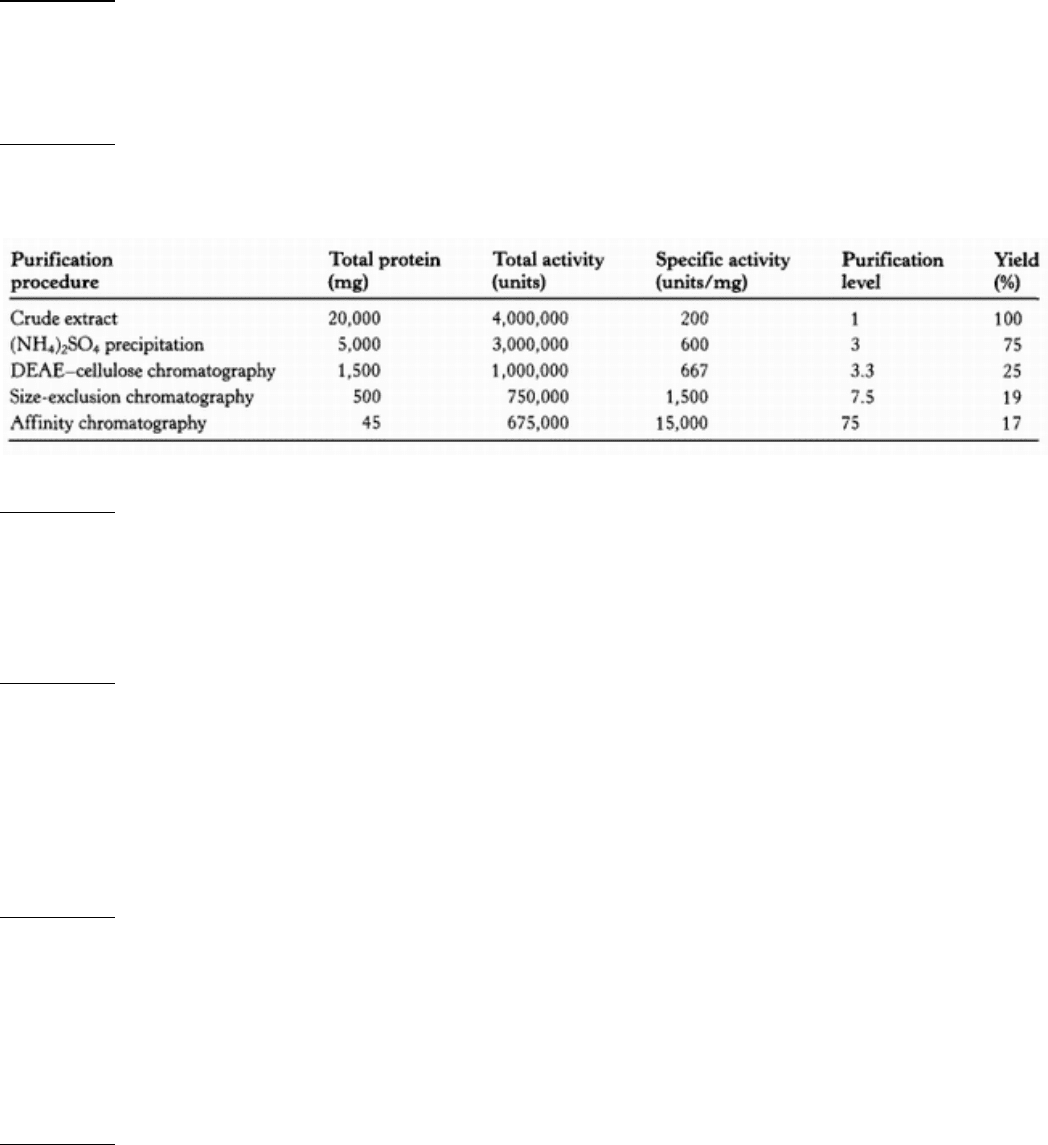
10.
(a) Trypsin cleaves after arginine (R) and lysine (K), generating AVGWR, VK, and S. Because they differ in size,
these products could be separated by molecular exclusion chromatography.
(b) Chymotrypsin, which cleaves after large aliphatic or aromatic R groups, generates two peptides of equal size
(AVGW) and (RVKS). Separation based on size would not be effective. The peptide RVKS has two positive
charges (R and K), whereas the other peptide is neutral. Therefore, the two products could be separated by ion-
exchange chromatography.
See question
11.
An inhibitor of the enzyme being purified might have been present and subsequently removed by a purification
step. This would lead to an apparent increase in the total amount of enzyme present.
See question
12.
See table below.
See question
13.
Treatment with urea will disrupt noncovalent bonds. Thus the original 60-kd protein must be made of two 30-kd
subunits. When these subunits are treated with urea and mercaptoethanol, a single 15-kd species results, suggesting
that disulfide bonds link the 30-kd subunits.
See question
14.
(a) Electrostatic repulsion between positively charged ε-amino groups hinders α-helix formation at pH 7. At pH 10,
the side chains become deprotonated, allowing α-helix formation.
(b) Poly-
l-glutamate is a random coil at pH 7 and becomes α helical below pH 4.5 because the γ-carboxylate groups
become protonated.
See question
15.
Light was used to direct the synthesis of these peptides. Each amino acid added to the solid support contained a
photolabile protecting group instead of a t-Boc protecting group at its α-amino group. Illumination of selected
regions of the solid support led to the release of the protecting group, which exposed the amino groups in these sites
to make them reactive. The pattern of masks used in these illuminations and the sequence of reactants define the
ultimate products and their locations.
See question
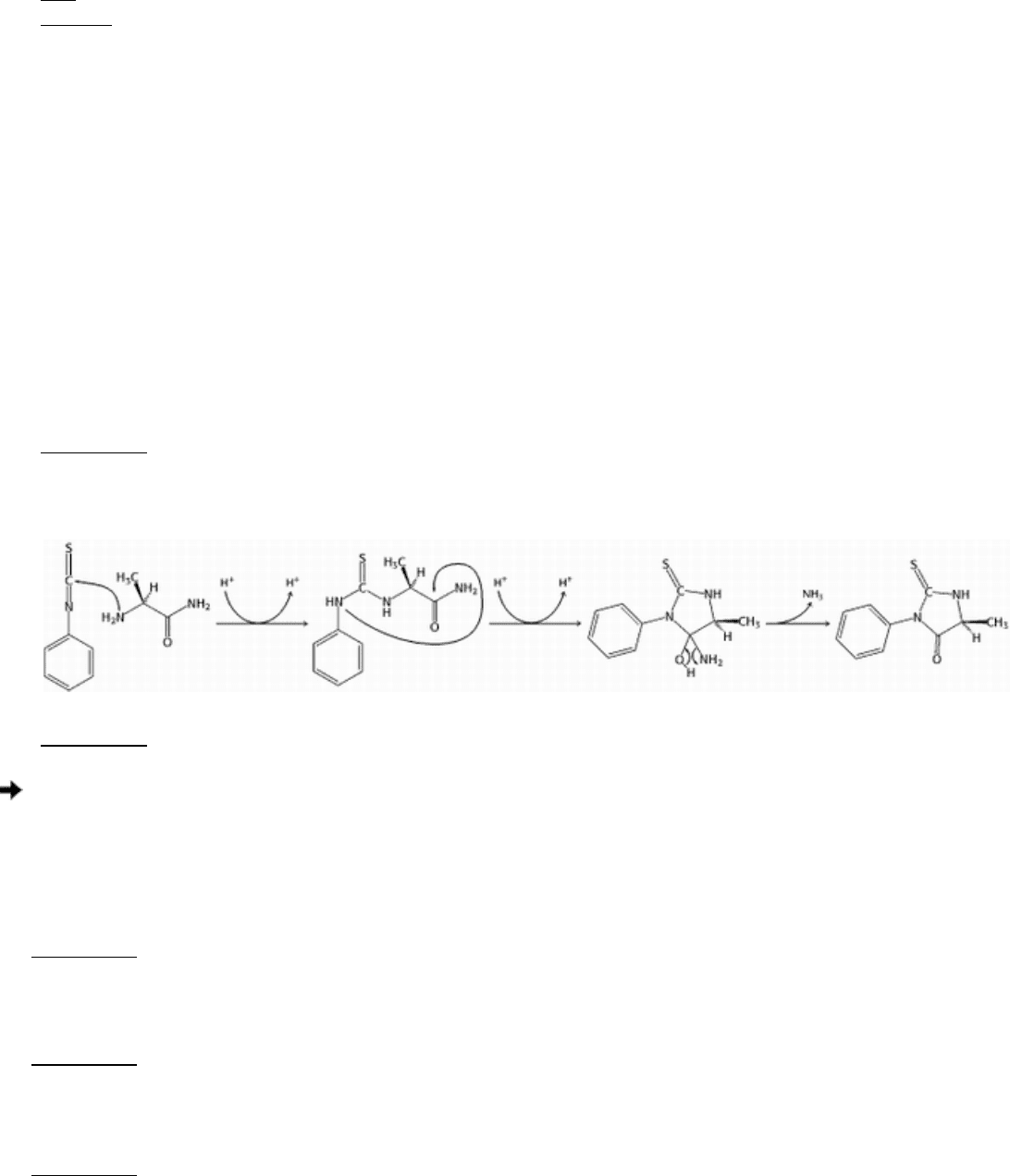
16.
AVRYSR
See
question
17.
First amino acid: S
Last amino acid: L
Cyanogen bromide cleavage: M is 10th position, C-terminal residues are: (2S,L,W)
Amino-terminal residues: (G,K,S,Y), tryptic peptide, ends in K
Amino-terminal sequence: SYGK
Chymotryptic peptide order: (S,Y), (G,K,L), (F,I,S), (M,T), (S,W), (S,L)
Sequence: SYGKLSIFTMSWSL
See question
18.
See equation below.
See question
Answers to Problems
Chapter 5
1.
(a) TTGATC; (b) GTTCGA; (c) ACGCGT; (d) ATGGTA.
See question
2.
(a) [T] + [C] = 0.46. (b) [T] = 0.30, [C] = 0.24, and [A] + [G] = 0.46.
See question
3.
5.7 × 10
3
base pairs.
See question
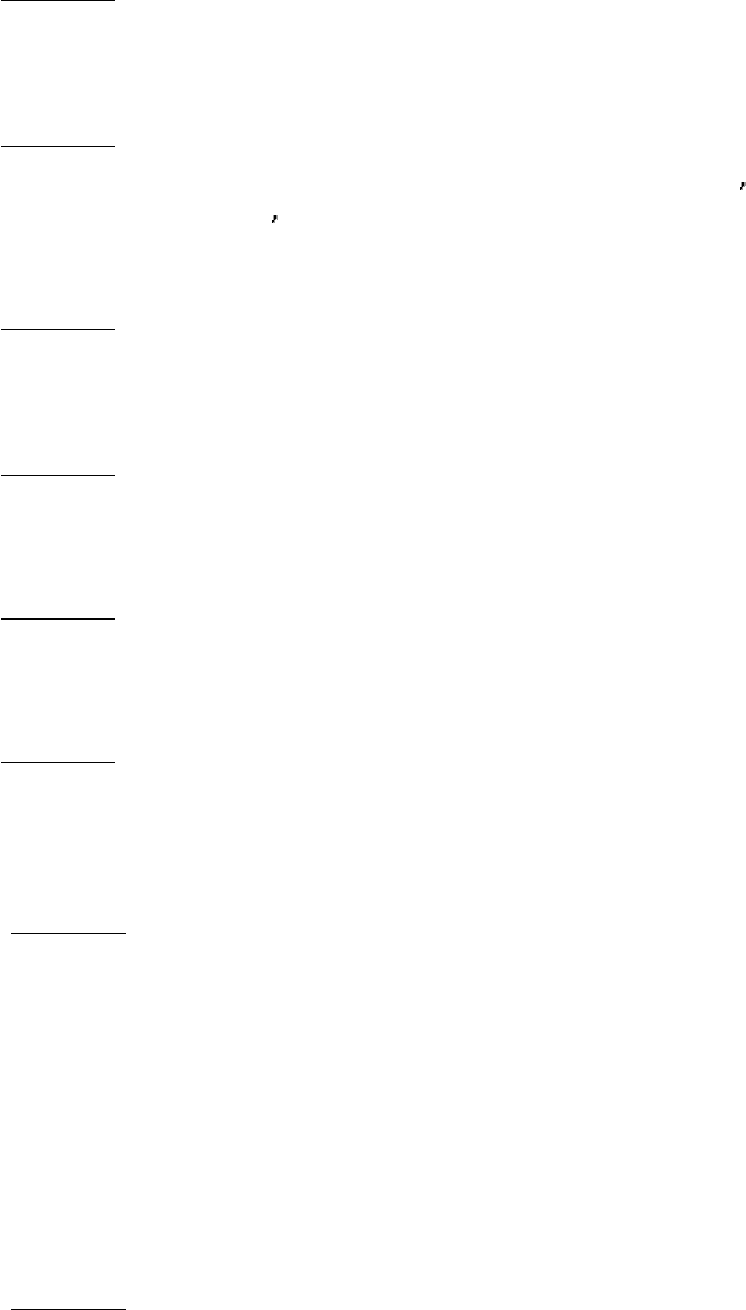
4.
In conservative replication, after 1.0 generation, half of the molecules would be
15
N-
15
N, the other half
14
N-
14
N.
After 2.0 generations, one-quarter of the molecules would be
15
N-
15
N, the other three-quarters
14
N-
14
N. Hybrid
14
N-
15
N molecules would not be observed in conservative replication.
See question
5.
(a) Tritiated thymine or tritiated thymidine. (b) dATP, dGTP, dCTP, and dTTP labeled with
32
P in the innermost (α)
phosphorus atom.
See question
6.
Molecules in parts a and b would not lead to DNA synthesis because they lack a 3 -OH group (a primer). The
molecule in part d has a free 3
-OH at one end of each strand but no template strand beyond. Only the molecule in
part c would lead to DNA synthesis.
See question
7.
A thymidylate oligonucleotide should be used as the primer. The poly(rA) template specifies the incorporation of T;
hence, radioactive TTP (labeled in the α-phosphate) should be used in the assay.
See question
8.
The ribonuclease serves to degrade the RNA strand, a necessary step in forming duplex DNA from the RNA-DNA
hybrid.
See question
9.
Treat one aliquot of the sample with ribonuclease and another with deoxyribonuclease. Test these nuclease-treated
samples for infectivity.
See question
10.
Deamination changes the original G · C base pair into a G · U pair. After one round of replication, one daughter
duplex will contain a G · C pair, and the other duplex an A · U pair. After two rounds of replication, there would be
two G · C pairs, one A · U pair, and one A · T pair.
See question
11.
(a) 4
8
= 65,536. In computer terminology, there are 64K 8-mers of DNA.
(b) A bit specifies two bases (say, A and C) and a second bit specifies the other two (G and T). Hence, two bits are
needed to specify a single nucleotide (base pair) in DNA. For example, 00, 01, 10, and 11 could encode A, C, G,
and T. An 8-mer stores 16 bits (2
16
= 65,536), the E. coli genome (4 × 10
6
bp) stores 8 × 10
6
bits, and the human
genome (2.9 × 10
9
bases) stores 5.8 × 10
9
bits of genetic information.
(c) A floppy diskette stores about 1.5 megabytes, which is equal to 1.2 × 10
7
bits. A large number of 8-mer
sequences could be stored on such a diskette. The DNA sequence of E. coli, could be written on a single diskette.
Nearly 500 diskettes would be needed to record the human DNA sequence.
See question
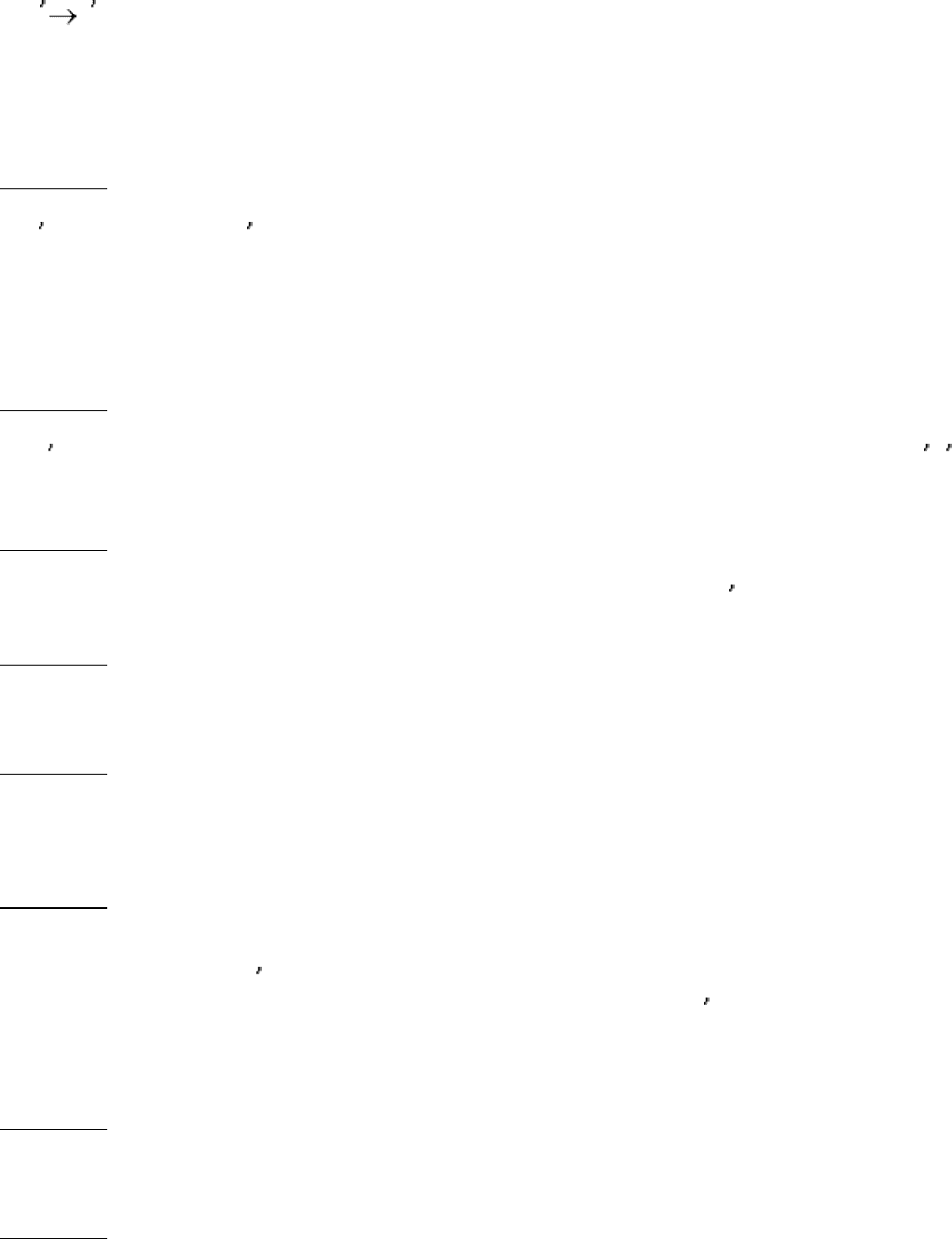
12.
(a) Deoxyribonucleoside triphosphates versus ribonucleoside triphosphates.
(b) 5
3 for both.
(c) Semiconserved for DNA polymerase I; conserved for RNA polymerase.
(d) DNA polymerase I needs a primer, whereas RNA polymerase does not.
See question
13.
(a) 5
-UAACGGUACGAU-3 .
(b) Leu-Pro-Ser-Asp-Trp-Met.
(c) Poly(Leu-Leu-Thr-Tyr).
See question
14.
The 2
-OH group in RNA acts as an intramolecular nucleophil. In the alkaline hydrolysis of RNA, it forms a 2 -3
cyclic intermediate.
See question
15.
Cordycepin terminates RNA synthesis. An RNA chain containing cordycepin lacks a 3
-OH group.
See question
16.
Only single-stranded RNA can serve as a template for protein synthesis.
See question
17.
Incubation with RNA polymerase and only UTP, ATP, and CTP led to the synthesis of only poly(UAC). Only poly
(GUA) was formed when GTP was used in place of CTP.
See question
18.
These alternatives were distinguished by the results of studies of the sequence of amino acids in mutants. Suppose
that the base C is mutated to C
. In a nonoverlapping code, only amino acid 1 will be changed. In a completely
overlapping code, amino acids 1, 2, and 3 will all be altered by a mutation of C to C
. The results of amino acid
sequence studies of tobacco mosaic virus mutants and abnormal hemoglobins showed that alterations usually
affected only a single amino acid. Hence, it was concluded that the genetic code is nonoverlapping.
See question
19.
A peptide terminating with Lys (UGA is a stop codon), -Asn-Glu-, and -Met-Arg-.
See question
